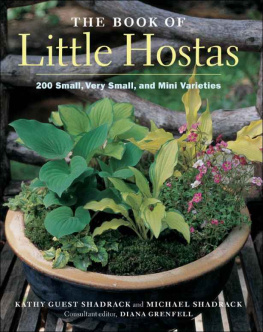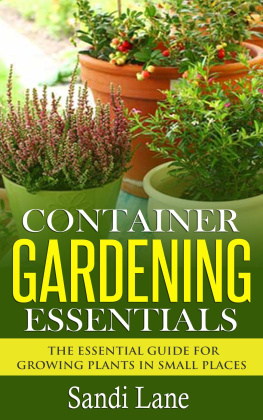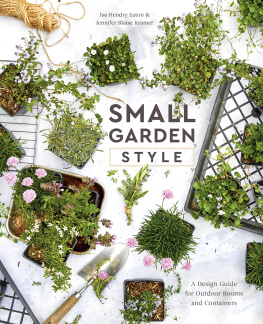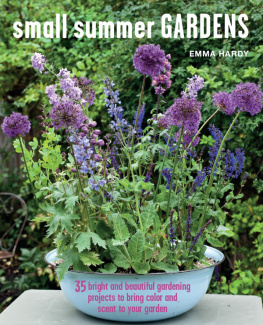THE BOOK OF
Little Hostas

THE BOOK OF
Little Hostas
200 Small, Very Small, and Mini Varieties
Kathy Guest Shadrack and Michael Shadrack
Consultant editor, Diana Grenfell

To our childrenJennifer, Vickie, Troy, and Emma
Four delightful young people
Copyright 2010 by Kathy Guest Shadrack and Michael Shadrack.
All rights reserved. All photographs are by the authors.
Frontispiece: A single miniature hosta, H. Cameo, in a terracotta
pot, draped with a dwarf ivy. In these very small containers, there
needs to be a strict watering regimen.
Published in 2010 by Timber Press, Inc.
The Haseltine Building 2 The Quadrant
133 S.W. Second Avenue, Suite 450 135 Salusbury Road
Portland, Oregon 97204-3527 London NW6 6RJ
www.timberpress.com www.timberpress.co.uk
Printed in China
Text designed by Susan Applegate
Library of Congress Cataloging-in-Publication Data
Shadrack, Kathy Guest.
The book of little hostas: 200 small, very small, and mini varieties/Kathy
Guest Shadrack and Michael Shadrack; consultant editor, Diana Grenfell.
1st ed.
p. cm.
Includes bibliographical references and index.
ISBN 978-1-60469-060-6
1. HostaVarieties. 2. Miniature plants. I. Shadrack, Michael. II.
Grenfell, Diana. III. Title.
SB413.H73S53 2010
635.93432dc22
2010012436
Catalog records for this book are available from the Library of Congress
and the British Library.
CONTENTS
PREFACE
HOSTAS HAVE ENJOYED great success, especially over the last twenty-five years, as a carefree, undemanding perennial of great diversity. There is a hosta for almost any site, and their sculptural beauty brings a bit of quiet sophistication to even the most exuberant flower garden.
Most of us are first drawn to large hostas. They make an imposing statement in the landscape and are often focal points; a magnificent H. Sum and Substance or a well-grown H. Komodo Dragon will catch the eye from across the garden. Most hosta collectors, too, begin with the larger plants. Then an evolution begins: as gardeners become more and more involved in collecting and growing the plants, they also become aware there exists a full spectrum of smaller hostas that mimic the shapes, colors, and textures of the larger hostas. There is every bit as much variety and variation in these garden gems, and it soon becomes clear that these smaller hostas can be as enthralling as the giantsand take up far less space and far less of the gardeners energy.
The smaller hostas have grown in popularity, especially over recent years, and it could be said that they now have almost a cult following. Hybridizers have taken notice, and more attention has been given to producing diminutive plants. The American Hosta Society (AHS) has also recognized the trend, not only by running a separate mini hosta popularity poll but also by establishing standards and definitions for small, very small, and miniature hostas.
Furthermore, as many of us no longer have the space or energy for a rolling garden, we turn to a more manageable space: a raised bed, a trough, or even a collection of potted plants on a deck or patio. Smaller hostas are perfectly suited to this focused kind of gardening. They add texture, color, and excitement in a confined area.
Little hostas, however, do take specialized care and siting in order to be grown optimally. The purpose of this book is to introduce you, the reader, to the palette of these small, very small, and miniature hostas, address how to grow them to perfection, and offer ideas on how to best use them in the garden, in containers, and as specimens. We hope that you find something in this book to stimulate, titillate, or otherwise encourage you to grow some little hostas, start a new collection, or create a landscape in miniature. We hope you might learn something new, or be stirred to learn more about one aspect or another touched upon here. If we do that, we have met our goal.
Acknowledgements
We would like first to thank Diana Grenfell, who unselfishly and generously provided the opportunity for this book, and then offered her total and absolute support so that we could accomplish it. As consultant editor, she has freely shared her experience and expertise, her eyes and criticism, her hard work and her enthusiasm. Diana has been a hosta champion to many, but to us she has also been a very special mentor and friend. There are no words that can adequately express our appreciation to her.
We appreciate Anna Mumford, our commissioning editor from Timber Press, who had confidence in our abilities, and we thank her for the clear and expert advice she gave us throughout the writing process.
We would like to thank Warren Pollock, who has spent many hours vettingand sometimes debatingmost of the chapters. We are grateful for his exceptional knowledge, practiced proofreading, and patience.
W. George Schmid has been wonderful and also exceptionally patient in explaining the intricacies of the species, endeavoring to keep us as correct as possible. He helped us to understand the roots of the smaller hostas.
Bob Solberg offered key assistance and advice about the nuances of growing small hostas well. He spent a great deal of time reading what we had written and then challenging the parts that needed challenging.
As well as the help and support we have received, we have tried to keep track of two years worth of photo opportunities, advice, gardens, quotes, and chance conversations. Our deep and humble appreciation to all those hosta friends, around the world, who gave us unrestricted access to their gardens and their knowledge, with special thanks to Tony Avent, Bob Bauer, Doug Beilstein, Sandra Bond, Ann and Roger Bowden, Carol Brashear, John Coble, Peter Cross and Oscar Cross, Walter Cullerton, C. H. Falstad, Marco and Joyce Fransen, Mike and Libby Greanya, Hans Hansen, Jack Hirsch, Jerry Kral, Bob Kuk, Mark Langden, Gary Lindheimer, Ran and Katie Lydell, Bill Meyer, Dick OMelay, Al Pfieffer, Hugo Philips, Kevin Plumley, Peter and Jean Ruh, Tim Saville, Carolyn Schaffner, Bill Silvers, Nancy Solberg, Van and Shirley Wade, Kevin Walek, Cynthia Wilhoite, Jim and Sandy Wilkins, and Mark Zilis.

Hosta venusta, one of the first small species hostas introduced to gardeners.
CHAPTER ONE
A Brief Introduction to Hostas
WHEN MOST PEOPLE THINK of hostas, what springs to mind are majestic plants with luxuriant leaves anchoring a shady corner of the garden. It still surprises some gardeners that hostas come in a myriad of sizes, and that small, very small, and miniature hostas are equally valuable, charming, and exciting when properly set in small spaces.
Hostas are clump-forming perennials, generally grown for their impressive foliage. Originating from Japan, China, and Korea, they first crossed to the West in the late 1700s, in the form of seeds collected from the sweetly fragrant flowers of H. plantaginea (August lily). Philipp von Siebold, Robert Fortune, most probably Thomas Hogg, and other early collectors introduced hostas to Europe and the United States during the plant collecting frenzy of the 1800s. These early hostas are still grown, although in some cases they offer little as decorative garden plants other than durability and dependability.












